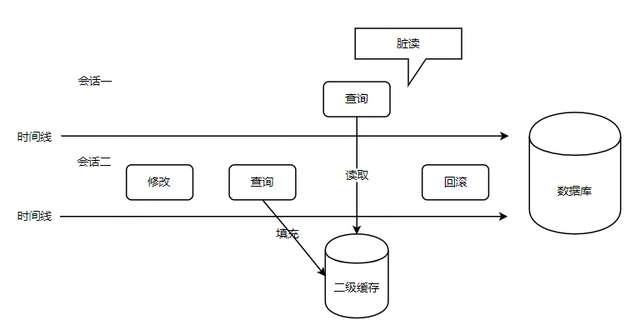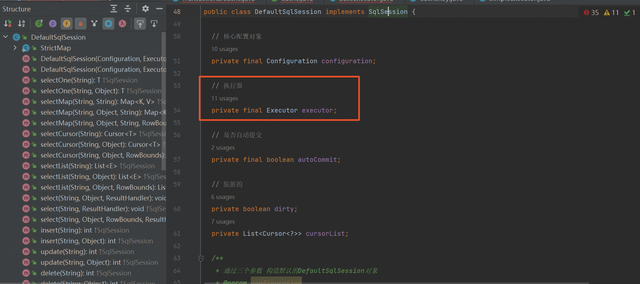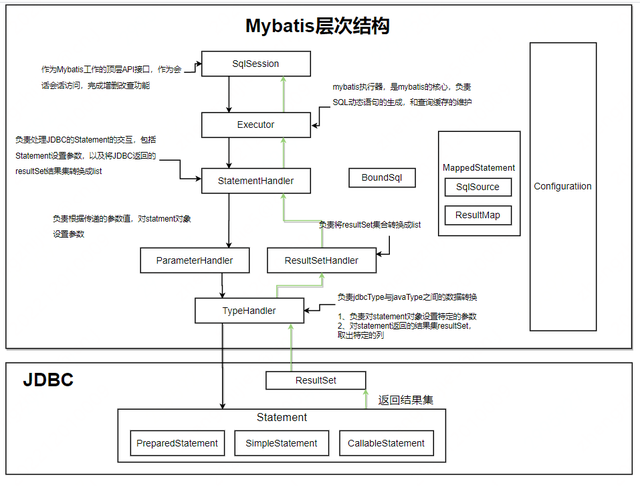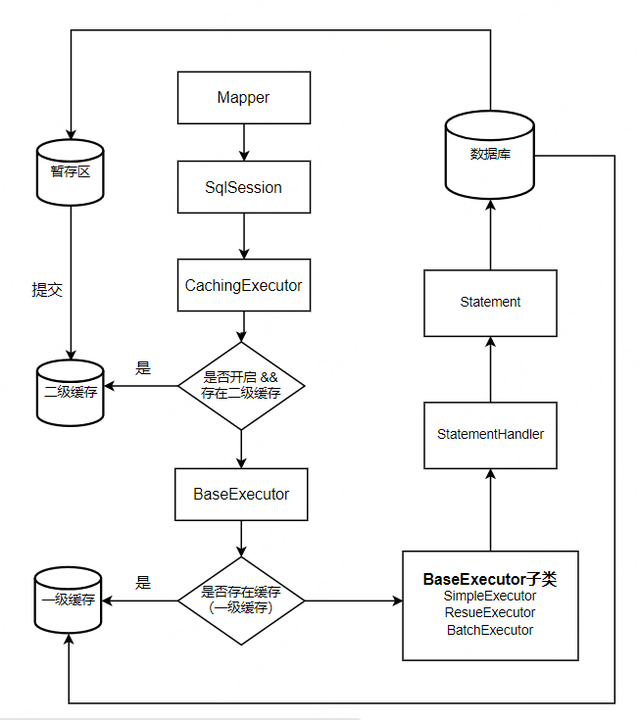Mybatis原始碼解析之執行SQL語句
作者:鄭志傑
mybatis 運算元據庫的過程
// 第一步:讀取mybatis-config.xml組態檔 InputStream inputStream = Resources.getResourceAsStream("mybatis-config.xml"); // 第二步:構建SqlSessionFactory(框架初始化) SqlSessionFactory sqlSessionFactory = new SqlSessionFactoryBuilder().bulid(); // 第三步:開啟sqlSession SqlSession session = sqlSessionFactory.openSession(); // 第四步:獲取Mapper介面物件(底層是動態代理) AccountMapper accountMapper = session.getMapper(AccountMapper.class); // 第五步:呼叫Mapper介面物件的方法運算元據庫; Account account = accountMapper.selectByPrimaryKey(1);
通過呼叫 session.getMapper (AccountMapper.class) 所得到的 AccountMapper 是一個動態代理物件,所以執行
accountMapper.selectByPrimaryKey (1) 方法前,都會被 invoke () 攔截,先執行 invoke () 中的邏輯。
public Object invoke(Object proxy, Method method, Object[] args) throws Throwable { try { // 要執行的方法所在的類如果是Object,直接呼叫,不做攔截處理 if (Object.class.equals(method.getDeclaringClass())) { return method.invoke(this, args); //如果是預設方法,也就是java8中的default方法 } else if (isDefaultMethod(method)) { // 直接執行default方法 return invokeDefaultMethod(proxy, method, args); } } catch (Throwable t) { throw ExceptionUtil.unwrapThrowable(t); } // 從快取中獲取MapperMethod final MapperMethod mapperMethod = cachedMapperMethod(method); return mapperMethod.execute(sqlSession, args); }
從 methodCache 獲取對應 DAO 方法的 MapperMethod
MapperMethod 的主要功能是執行 SQL 語句的相關操作,在初始化的時候會範例化兩個物件:SqlCommand(Sql 命令)和 MethodSignature(方法簽名)。
/** * 根據Mapper介面型別、介面方法、核心設定物件 構造MapperMethod物件 * @param mapperInterface * @param method * @param config */ public MapperMethod(Class<?> mapperInterface, Method method, Configuration config) { this.command = new SqlCommand(config, mapperInterface, method); // 將Mapper介面中的資料庫操作方法(如Account selectById(Integer id);)封裝成方法簽名MethodSignature this.method = new MethodSignature(config, mapperInterface, method); }
new SqlCommand()呼叫 SqlCommand 類構造方法:
public SqlCommand(Configuration configuration, Class<?> mapperInterface, Method method) { // 獲取Mapper介面中要執行的某個方法的方法名 // 如accountMapper.selectByPrimaryKey(1) final String methodName = method.getName(); // 獲取方法所在的類 final Class<?> declaringClass = method.getDeclaringClass(); // 解析得到Mapper語句物件(對組態檔中的<mapper></mapper>中的sql語句進行封裝) MappedStatement ms = resolveMappedStatement(mapperInterface, methodName, declaringClass, configuration); if (ms == null) { if (method.getAnnotation(Flush.class) != null) { name = null; type = SqlCommandType.FLUSH; } else { throw new BindingException("Invalid bound statement (not found): " + mapperInterface.getName() + "." + methodName); } } else { // 如com.bjpowernode.mapper.AccountMapper.selectByPrimaryKey name = ms.getId(); // SQL型別:增 刪 改 查 type = ms.getSqlCommandType(); if (type == SqlCommandType.UNKNOWN) { throw new BindingException("Unknown execution method for: " + name); } } } private MapperMethod cachedMapperMethod(Method method) { MapperMethod mapperMethod = (MapperMethod)this.methodCache.get(method); if (mapperMethod == null) { mapperMethod = new MapperMethod(this.mapperInterface, method, this.sqlSession.getConfiguration()); this.methodCache.put(method, mapperMethod); } return mapperMethod; }
呼叫 mapperMethod.execute (sqlSession, args)
在 mapperMethod.execute () 方法中,我們可以看到:mybatis 定義了 5 種 SQL 操作型別:
insert/update/delete/select/flush。其中,select 操作型別又可以分為五類,這五類的返回結果都不同,分別對應:
・返回引數為空:executeWithResultHandler ();
・查詢多條記錄:executeForMany (),返回物件為 JavaBean
・返參物件為 map:executeForMap (), 通過該方法查詢資料庫,最終的返回結果不是 JavaBean,而是 Map
・遊標查詢:executeForCursor ();關於什麼是遊標查詢,自行百度哈;
・查詢單條記錄: sqlSession.selectOne (),通過該查詢方法,最終只會返回一條結果;
通過原始碼追蹤我們可以不難發現:當呼叫 mapperMethod.execute () 執行 SQL 語句的時候,無論是
insert/update/delete/flush,還是 select(包括 5 種不同的 select), 本質上時通過 sqlSession 呼叫的。在 SELECT 操作中,雖然呼叫了 MapperMethod 中的方法,但本質上仍是通過 Sqlsession 下的 select (), selectList (), selectCursor (), selectMap () 等方法實現的。
而 SqlSession 的內部實現,最終是呼叫執行器 Executor(後面會細說)。這裡,我們可以先大概看一下 mybatis 在執行 SQL 語句的時候的呼叫過程:

以accountMapper.selectByPrimaryKey (1) 為例:
・呼叫 SqlSession.getMapper ():得到 xxxMapper (如 UserMapper) 的動態代理物件;
・呼叫
accountMapper.selectByPrimaryKey (1):在 xxxMapper 動態代理內部,會根據要執行的 SQL 語句型別 (insert/update/delete/select/flush) 來呼叫 SqlSession 對應的不同方法,如 sqlSession.insert ();
・在 sqlSession.insert () 方法的實現邏輯中,又會轉交給 executor.query () 進行查詢;
・executor.query () 又最終會轉交給 statement 類進行操作,到這裡就是 jdbc 操作了。
有人會好奇,為什麼要通過不斷的轉交,SqlSession->Executor->Statement,而不是直接呼叫 Statement 執行 SQL 語句呢?因為在呼叫 Statement 之前,會處理一些共性的邏輯,如在 Executor 的實現類 BaseExecutor 會有一級快取相關的邏輯,在 CachingExecutor 中會有二級快取的相關邏輯。如果直接呼叫 Statement 執行 SQL 語句,那麼在每個 Statement 的實現類中,都要寫一套一級快取和二級快取的邏輯,就顯得冗餘了。這一塊後面會細講。
// SQL命令(在解析mybatis-config.xml組態檔的時候生成的) private final SqlCommand command; public Object execute(SqlSession sqlSession, Object[] args) { Object result; // 從command物件中獲取要執行操作的SQL語句的型別,如INSERT/UPDATE/DELETE/SELECT switch (command.getType()) { // 插入 case INSERT: { // 把介面方法裡的引數轉換成sql能識別的引數 // 如:accountMapper.selectByPrimaryKey(1) // 把其中的引數"1"轉化為sql能夠識別的引數 Object param = method.convertArgsToSqlCommandParam(args); // sqlSession.insert(): 呼叫SqlSession執行插入操作 // rowCountResult(): 獲取SQL語句的執行結果 result = rowCountResult(sqlSession.insert(command.getName(), param)); break; } // 更新 case UPDATE: { Object param = method.convertArgsToSqlCommandParam(args); // sqlSession.insert(): 呼叫SqlSession執行更新操作 // rowCountResult(): 獲取SQL語句的執行結果 result = rowCountResult(sqlSession.update(command.getName(), param)); break; } // 刪除 case DELETE: { Object param = method.convertArgsToSqlCommandParam(args); // sqlSession.insert(): 呼叫SqlSession執行更新操作 // rowCountResult(): 獲取SQL語句的執行結果 result = rowCountResult(sqlSession.delete(command.getName(), param)); break; } // 查詢 case SELECT: // method.returnsVoid(): 返參是否為void // method.hasResultHandler(): 是否有對應的結果處理器 if (method.returnsVoid() && method.hasResultHandler()) { executeWithResultHandler(sqlSession, args); result = null; } else if (method.returnsMany()) { // 查詢多條記錄 result = executeForMany(sqlSession, args); } else if (method.returnsMap()) { // 查詢結果返參為Map result = executeForMap(sqlSession, args); } else if (method.returnsCursor()) { // 以遊標的方式進行查詢 result = executeForCursor(sqlSession, args); } else { // 引數轉換 轉成sqlCommand引數 Object param = method.convertArgsToSqlCommandParam(args); // 執行查詢 查詢單條資料 result = sqlSession.selectOne(command.getName(), param); if (method.returnsOptional() && (result == null || !method.getReturnType().equals(result.getClass()))) { result = Optional.ofNullable(result); } } break; case FLUSH: // 執行清除操作 result = sqlSession.flushStatements(); break; default: throw new BindingException("Unknown execution method for: " + command.getName()); } if (result == null && method.getReturnType().isPrimitive() && !method.returnsVoid()) { throw new BindingException("Mapper method '" + command.getName() + " attempted to return null from a method with a primitive return type (" + method.getReturnType() + ")."); } return result; }
在上面,有多處出現這樣一行程式碼:
method.convertArgsToSqlCommandParam (args),該方法的作用就是將方法引數轉換為 SqlCommandParam;具體交由
paramNameResolver.getNamedParams () 實現。在看 paramNameResolver.getNamedParams () 之前,我們先來看下 paramNameResolver 是什麼東西?
public Object convertArgsToSqlCommandParam(Object[] args) { return paramNameResolver.getNamedParams(args); }
在前面,我們在範例化 MethodSignature 物件 (new MethodSignature) 的時候,在其構造方法中,會範例化 ParamNameResolver 物件,該物件主要用來處理介面形式的引數,最後會把引數處放在一個 map(即屬性 names)中。map 的 key 為引數的位置,value 為引數的名字。
public MethodSignature(Configuration configuration, Class<?> mapperInterface, Method method) { ... this.paramNameResolver = new ParamNameResolver(configuration, method); }
對 names 欄位的解釋:
假設在 xxxMapper 中有這麼一個介面方法 selectByIdAndName ()
・selectByIdAndName (@Param ("id") String id, @Param ("name") String name) 轉化為 map 為 {{0, "id"}, {1, "name"}}
・selectByIdAndName (String id, String name) 轉化為 map 為 {{0, "0"}, {1, "1"}}
・selectByIdAndName (int a, RowBounds rb, int b) 轉化為 map 為 {{0, "0"}, {2, "1"}}
構造方法的會經歷如下的步驟
1. 通過反射得到方法的引數型別和方法的引數註解註解,
method.getParameterAnnotations () 方法返回的是註解的二維陣列,每一個方法的引數包含一個註解陣列。
2. 遍歷所有的引數
- 首先判斷這個引數的型別是否是特殊型別,RowBounds 和 ResultHandler,是的話跳過,咱不處理
- 判斷這個引數是否是用來 Param 註解,如果使用的話 name 就是 Param 註解的值,並把 name 放到 map 中,鍵為引數在方法中的位置,value 為 Param 的值
- 如果沒有使用 Param 註解,判斷是否開啟了 UseActualParamName,如果開啟了,則使用 java8 的反射得到方法的名字,此處容易造成異常,
具體原因參考上一篇博文.
- 如果以上條件都不滿足的話,則這個引數的名字為引數的下標
// 通用key字首,因為key有param1,param2,param3等; public static final String GENERIC_NAME_PREFIX = "param"; // 存放引數的位置和對應的引數名 private final SortedMap<Integer, String> names; // 是否使用@Param註解 private boolean hasParamAnnotation; public ParamNameResolver(Configuration config, Method method) { // 通過註解得到方法的引數型別陣列 final Class<?>[] paramTypes = method.getParameterTypes(); // 通過反射得到方法的引數註解陣列 final Annotation[][] paramAnnotations = method.getParameterAnnotations(); // 用於儲存所有引數名的SortedMap物件 final SortedMap<Integer, String> map = new TreeMap<>(); // 引數註解陣列長度,即方法入參中有幾個地方使用了@Param // 如selectByIdAndName(@Param("id") String id, @Param("name") String name)中,paramCount=2 int paramCount = paramAnnotations.length; // 遍歷所有的引數 for (int paramIndex = 0; paramIndex < paramCount; paramIndex++) { // 判斷這個引數的型別是否是特殊型別,RowBounds和ResultHandler,是的話跳過 if (isSpecialParameter(paramTypes[paramIndex])) { continue; } String name = null; for (Annotation annotation : paramAnnotations[paramIndex]) { // 判斷這個引數是否使用了@Param註解 if (annotation instanceof Param) { // 標記當前方法使用了Param註解 hasParamAnnotation = true; // 如果使用的話name就是Param註解的值 name = ((Param) annotation).value(); break; } } // 如果經過上面處理,引數名還是null,則說明當前引數沒有指定@Param註解 if (name == null) { // 判斷是否開啟了UseActualParamName if (config.isUseActualParamName()) { // 如果開啟了,則使用java8的反射得到該引數對應的屬性名 name = getActualParamName(method, paramIndex); } // 如果name還是為null if (name == null) { // use the parameter index as the name ("0", "1", ...) // 使用引數在map中的下標作為引數的name,如 ("0", "1", ...) name = String.valueOf(map.size()); } } // 把引數放入到map中,key為引數在方法中的位置,value為引數的name(@Param的value值/引數對應的屬性名/引數在map中的位置下標) map.put(paramIndex, name); } // 最後使用Collections工具類的靜態方法將結果map變為一個不可修改型別 names = Collections.unmodifiableSortedMap(map); }
getNamedParams(): 該方法會將引數名和引數值對應起來,並且還會額外儲存一份以 param 開頭加引數順序數位的值
public Object getNamedParams(Object[] args) { // 這裡的names就是ParamNameResolver中的names,在構造ParamNameResolver物件的時候,建立了該Map // 獲取方法引數個數 final int paramCount = names.size(); // 沒有引數 if (args == null || paramCount == 0) { return null; // 只有一個引數,並且沒有使用@Param註解。 } else if (!hasParamAnnotation && paramCount == 1) { // 直接返回,不做任務處理 return args[names.firstKey()]; } else { // 包裝成ParamMap物件。這個物件繼承了HashMap,重寫了get方法。 final Map<String, Object> param = new ParamMap<>(); int i = 0; // 遍歷names中的所有鍵值對 for (Map.Entry<Integer, String> entry : names.entrySet()) { // 將引數名作為key, 對應的引數值作為value,放入結果param物件中 param.put(entry.getValue(), args[entry.getKey()]); // 用於新增通用的引數名稱,按順序命名(param1, param2, ...) final String genericParamName = GENERIC_NAME_PREFIX + (i + 1); // 確保不覆蓋以@Param 命名的引數 if (!names.containsValue(genericParamName)) { param.put(genericParamName, args[entry.getKey()]); } i++; } return param; } } }
getNamedParams () 總結:
1. 當只有一個引數的時候,直接返回,不做任務處理;
2. 否則,存入 Map 中,鍵值對形式為:paramName=paramValue
・selectByIdAndName (@Param ("id") String id, @Param ("name") String name): 傳入的引數是 ["1", "張三"],最後解析出來的 map 為:{「id」:」1」,」「name」:」 張三」}
・selectByIdAndName (String id, @Param ("name") String name): 傳入的引數是 ["1", "張三"],最後解析出來的 map 為:{「param1」:」1」,」「name」:」 張三」}
假設執行的 SQL 語句是 select 型別,繼續往下看程式碼
在 mapperMethod.execute (), 當
convertArgsToSqlCommandParam () 方法處理完方法引數後,假設我們此時呼叫的是查詢單條記錄,那麼接下來會執行 sqlSession.selectOne () 方法。
sqlSession.selectOne () 原始碼分析:
sqlSession.selectOne () 也是調的 sqlSession.selectList () 方法,只不過只返回 list 中的第一條資料。當 list 中有多條資料時,拋異常。
@Override public <T> T selectOne(String statement, Object parameter) { // 呼叫當前類的selectList方法 List<T> list = this.selectList(statement, parameter); if (list.size() == 1) { return list.get(0); } else if (list.size() > 1) { throw new TooManyResultsException("Expected one result (or null) to be returned by selectOne(), but found: " + list.size()); } else { return null; } }
sqlSession.selectList () 方法
@Override public <E> List<E> selectList(String statement, Object parameter) { return this.selectList(statement, parameter, RowBounds.DEFAULT); }
繼續看:
@Override public <E> List<E> selectList(String statement, Object parameter, RowBounds rowBounds) { try { // 從Configuration裡的mappedStatements里根據key(id的全路徑)獲取MappedStatement物件 MappedStatement ms = configuration.getMappedStatement(statement); // 呼叫Executor的實現類BaseExecutor的query()方法 return executor.query(ms, wrapCollection(parameter), rowBounds, Executor.NO_RESULT_HANDLER); } catch (Exception e) { throw ExceptionFactory.wrapException("Error querying database. Cause: " + e, e); } finally { ErrorContext.instance().reset(); } }
在 sqlSession.selectList () 方法中,我們可以看到呼叫了 executor.query (),假設我們開啟了二級快取,那麼 executor.query () 呼叫的是 executor 的實現類 CachingExecutor 中的 query (),二級快取的邏輯就是在 CachingExecutor 這個類中實現的。
關於 mybatis 二級快取:
二級快取預設是不開啟的,需要手動開啟二級快取,實現二級快取的時候,MyBatis 要求返回的 POJO 必須是可序列化的。快取中儲存的是序列化之後的,所以不同的對談操作物件不會改變快取。
怎麼開啟二級快取:
<settings>
<setting name = "cacheEnabled" value = "true" />
</settings>
怎麼使用二級快取?
1. 首先肯定是要開啟二級快取啦~
2. 除此之外,要使用二級快取還要滿足以下條件:
・當對談提交之後才會填充二級快取(為什麼?後面會解釋)
・SQL 語句相同,引數相同
・相同的 statementID
・RowBounds 相同
為什麼要對談提交後才會填充二級快取?
首先,我們知道,與一級快取(對談級快取)不同的是,二級快取是跨執行緒使用的,也就是多個對談可以一起使用同一個二級快取。假設現在不用提交便可以填充二級快取,我們看看會存在什麼問題?
假設對談二現在對資料庫進行了修改操作,修改完進行了查詢操縱,如果不用提交就會填充二級快取的話,這時候查詢操作會把剛才修改的資料填充到二級快取中,如果此時剛好對談一執行了查詢操作,便會查詢到二級快取中的資料。如果對談二最終回滾了剛才的修改操作,那麼對談一就相當於發生了髒讀。

實際上,查詢的時候會填充快取,只不過此時是填充在暫存區,而不是填充在真正的二級快取區中。而上面所說的要對談提交後才會填充二級快取,指的是將暫存區中的快取刷到真正的二級快取中。啊???那不對呀,填充在暫存區,那此時對談一來查詢,豈不是還會從暫存區中取到快取,從而導致髒讀?別急,接著往下看。
對於查詢操作,每次取快取都是從真正的二級快取中取快取,而不是從暫存區中取快取。
好了,我們接著看原始碼~
CachingExecutor.query () 原始碼:
@Override public <E> List<E> query(MappedStatement ms, Object parameterObject, RowBounds rowBounds, ResultHandler resultHandler) throws SQLException { // 獲取要執行的sql語句 sql語句在解析xml的時候就已經解析好了 BoundSql boundSql = ms.getBoundSql(parameterObject); // 生成二級快取key CacheKey key = createCacheKey(ms, parameterObject, rowBounds, boundSql); // 呼叫過載方法 return query(ms, parameterObject, rowBounds, resultHandler, key, boundSql); }
呼叫過載方法:query ()
@Override public <E> List<E> query(MappedStatement ms, Object parameterObject, RowBounds rowBounds, ResultHandler resultHandler, CacheKey key, BoundSql boundSql) throws SQLException { // 獲取mybatis的二級快取設定<cache> Cache cache = ms.getCache(); // 如果設定了二級快取 if (cache != null) { // 是否要重新整理快取,是否手動設定了需要清空快取 flushCacheIfRequired(ms); if (ms.isUseCache() && resultHandler == null) { ensureNoOutParams(ms, boundSql); @SuppressWarnings("unchecked") // 從二級快取中獲取值 List<E> list = (List<E>) tcm.getObject(cache, key); // 從二級快取中取不到值 if (list == null) { // 交由delegate查詢 這裡的delegate指向的是BaseExecutor // BaseExecutor中實現了一級快取的相關邏輯 // 也就是說,當在二級快取中獲取不到值的時候,會從一級快取中獲取,一級快取要是還是獲取不到 // 才會去查詢資料庫 list = delegate.query(ms, parameterObject, rowBounds, resultHandler, key, boundSql); // 將查詢結果存放在暫存區中,只有對談提交後才會將資料刷到二級快取,避免髒讀問題 tcm.putObject(cache, key, list); // issue #578 and #116 } return list; } } return delegate.query(ms, parameterObject, rowBounds, resultHandler, key, boundSql); }
接著,我們看下 BaseExecutor.query () 是怎麼實現一級快取邏輯的:
@SuppressWarnings("unchecked") @Override public <E> List<E> query(MappedStatement ms, Object parameter, RowBounds rowBounds, ResultHandler resultHandler, CacheKey key, BoundSql boundSql) throws SQLException { ErrorContext.instance().resource(ms.getResource()).activity("executing a query").object(ms.getId()); if (closed) { throw new ExecutorException("Executor was closed."); } if (queryStack == 0 && ms.isFlushCacheRequired()) { clearLocalCache(); } List<E> list; try { queryStack++; // 嘗試從快取中獲取結果 一級快取 list = resultHandler == null ? (List<E>) localCache.getObject(key) : null; if (list != null) { handleLocallyCachedOutputParameters(ms, key, parameter, boundSql); } else {// 從快取中獲取不到結果時 // 從資料庫中查詢資料 list = queryFromDatabase(ms, parameter, rowBounds, resultHandler, key, boundSql); } } finally { queryStack--; } if (queryStack == 0) { // 回到主查詢 // 遍歷延遲載入中的資料 for (DeferredLoad deferredLoad : deferredLoads) { // 把延遲載入的資料載入到結果集中 deferredLoad.load(); } // issue #601 deferredLoads.clear(); if (configuration.getLocalCacheScope() == LocalCacheScope.STATEMENT) { // issue #482 clearLocalCache(); } } return list; }
當從一級快取中獲取不到資料時,會查資料庫:
呼叫
BaseExecutor.queryFromDatabase()
private <E> List<E> queryFromDatabase(MappedStatement ms, Object parameter, RowBounds rowBounds, ResultHandler resultHandler, CacheKey key, BoundSql boundSql) throws SQLException { List<E> list; // 預留位置 (解決迴圈依賴問題) localCache.putObject(key, EXECUTION_PLACEHOLDER); try { // 執行查詢操作 list = doQuery(ms, parameter, rowBounds, resultHandler, boundSql); } finally { // 將預留位置從快取中移除 localCache.removeObject(key); } // 將查詢結果放入到一級快取中 localCache.putObject(key, list); if (ms.getStatementType() == StatementType.CALLABLE) { localOutputParameterCache.putObject(key, parameter); } return list; }
呼叫 BaseExecutor.doQuery ():在 BaseExecutor 中,doQuery () 只是個抽象方法,具體交由子類實現:
protected abstract <E> List<E> doQuery(MappedStatement ms, Object parameter, RowBounds rowBounds, ResultHandler resultHandler, BoundSql boundSql) throws SQLException;
從前面的流程中可知,在每次執行 CURD 的時候,都需要獲取 SqlSession 這個物件,介面如下:
可以看出來這個介面主要定義類關於 CRUD、資料庫事務、資料庫重新整理等相關操作。下面看它的預設實現類:

可以看到 DefaultSqlSession 實現了 SqlSession 中的方法,(其實我們自己也可根據需要去實現)。而在 DefaultSqlSession 類中有一個很重要的屬性,就是 Mybatis 的執行器(Executor)。
Executor 介紹:
Executor 執行器,是 mybatis 中執行查詢的主要程式碼,Executor 分為三種:
・簡單執行器 SimpleExecutor
・可重用執行器 ReuseExecutor
・批次執行器 BatchExecutor
預設使用的執行器是 SimpleExecutor,可以在 mybatis 的組態檔中設定使用哪種執行器
public class Configuration { protected ExecutorType defaultExecutorType = ExecutorType.SIMPLE; }
Executor 類圖:

假設我們使用的就是預設的執行器,SimpleExecutor。我們來看下 SimpleExecutor.doQuery ()
@Override public <E> List<E> doQuery(MappedStatement ms, Object parameter, RowBounds rowBounds, ResultHandler resultHandler, BoundSql boundSql) throws SQLException { // 這裡就進入jdbc了 Statement stmt = null; try { // 獲取核心設定物件 Configuration configuration = ms.getConfiguration(); StatementHandler handler = configuration.newStatementHandler(wrapper, ms, parameter, rowBounds, resultHandler, boundSql); //預編譯SQL語句 stmt = prepareStatement(handler, ms.getStatementLog()); // 執行查詢 return handler.query(stmt, resultHandler); } finally { closeStatement(stmt); } } private Statement prepareStatement(StatementHandler handler, Log statementLog) throws SQLException { Statement stmt; // 獲取連線 這裡的連線是代理連線 Connection connection = getConnection(statementLog); // 預編譯 stmt = handler.prepare(connection, transaction.getTimeout()); // 給預編譯sql語句設定引數 handler.parameterize(stmt); return stmt; }
在上面的原始碼中,我們可以看到 StatementHandler,它是用來幹嘛的?
在 mybatis 中,通過 StatementHandler 來處理與 JDBC 的互動,我們看下 StatementHandler 的類圖:

可以看出,跟 Executor 的繼承實現很像,都有一個 Base,Base 下面又有幾個具體實現子類,很明顯,採用了模板模式。不同於 CacheExecutor 用於二級快取之類的實際作用,這裡的 RoutingStatementHandler 僅用於維護三個 Base 子類的建立與呼叫。
•BaseStatementHandler
・SimpleStatementHandler:JDBC 中的 Statement 介面,處理簡單 SQL 的
・CallableStatementHandler:JDBC 中的 PreparedStatement,預編譯 SQL 的介面
・PreparedStatementHandler:JDBC 中的 CallableStatement,用於執行儲存過程相關的介面
・RoutingStatementHandler:路由三個 Base 子類,負責其建立及呼叫
public RoutingStatementHandler(Executor executor, MappedStatement ms, Object parameter, RowBounds rowBounds, ResultHandler resultHandler, BoundSql boundSql) { switch (ms.getStatementType()) { // 策略模式:根據不同語句型別 選用不同的策略實現類 case STATEMENT: delegate = new SimpleStatementHandler(executor, ms, parameter, rowBounds, resultHandler, boundSql); break; case PREPARED: delegate = new PreparedStatementHandler(executor, ms, parameter, rowBounds, resultHandler, boundSql); break; case CALLABLE: delegate = new CallableStatementHandler(executor, ms, parameter, rowBounds, resultHandler, boundSql); break; default: throw new ExecutorException("Unknown statement type: " + ms.getStatementType()); } }
嗯,很眼熟的策略模式,按照 statementType 的值來決定返回哪種 StatementHandler。
那這裡的 statementType 是在哪裡賦值的呢?我們看下 MappedStatement 的構造方法:
public Builder(Configuration configuration, String id, SqlSource sqlSource, SqlCommandType sqlCommandType) { ... // 構造方法中預設取值為PREPARED mappedStatement.statementType = StatementType.PREPARED; ... }
如果不想使用的 StatementType.PREPARED,怎麼自定義呢?
(1) 在 xxxMapper.xml 中:可以通過 <select /> 的 statementType 屬性指定
<select id="getAll" resultType="Student2" statementType="CALLABLE"> SELECT * FROM Student </select>
(2) 如果採用的是註解開發:通過 @SelectKey 的 statementType 屬性指定
@SelectKey(keyProperty = "account", before = false, statementType = StatementType.STATEMENT, statement = "select * from account where id = #{id}", resultType = Account.class) Account selectByPrimaryKey(@Param("id") Integer id);
到此,select 型別的 SQL 語句就基本執行完畢了,我們來總結一下 mybatis
MyBatis 的主要的核心部件有以下幾個:
SqlSession:作為 MyBatis 工作的主要頂層 API,表示和資料庫互動的對談,完成必要資料庫增刪改查功能;
Executor:MyBatis 執行器,是 MyBatis 排程的核心,負責 SQL 語句的生成和查詢快取的維護;
StatementHandler:封裝了 JDBC Statement 操作,負責對 JDBC statement 的操作,如設定引數、將 Statement 結果集轉換成 List 集合。
ParameterHandler:負責對使用者傳遞的引數轉換成 JDBC Statement 所需要的引數;
ResultSetHandler:負責將 JDBC 返回的 ResultSet 結果集物件轉換成 List 型別的集合;
TypeHandler:負責 java 資料型別和 jdbc 資料型別之間的對映和轉換;
MappedStatement:MappedStatement 維護了一條 <select|update|delete|insert> 節點的封裝;
SqlSource:負責根據使用者傳遞的 parameterObject,動態地生成 SQL 語句,將資訊封裝到 BoundSql 物件中,並返回;
BoundSql:表示動態生成的 SQL 語句以及相應的引數資訊;
Configuration:MyBatis 所有的設定資訊都維持在 Configuration 物件之中;

